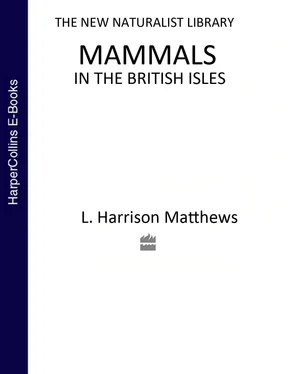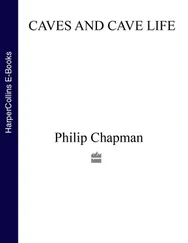It was for this reason that we persuaded Dr Matthews to produce an entirely new book. It is in no way a revision of the 1952 publication. Although considerably shorter than its predecessor, it covers all facets of the life of the mammals of the British Isles. Like others in this series, it is not a text book. Several admirable volumes of this nature are now available; this has made it possible to reduce the description of the species to a minimum. Once more the author has produced a synthesis of modern knowledge, which treats mammals as living creatures, living in and adapted to their environment. We are confident that it will meet a real need of today’s readers, and that it is a worthy successor to the author’s previous volume.
AUTHOR’S PREFACE
THIRTY years have passed since my volume ‘British Mammals’ was published as No. 21 in the New Naturalist series, and a large amount of new information has come to hand during that time. The cost of resetting a fully revised new edition was too expensive for the publishers to face; I had therefore to insist that it should be allowed to go out of print – I could not let readers be fobbed off with so out-of-date a book. Paradoxically, the publishers then asked me to write a new and different book on our mammals, and here it is.
I have tried to give a general picture of the British mammals and the things influencing their numbers and distribution both now and in the past, together with the history and development of their environment. I then examine various aspects of their biology, dealing with them as living animals in the field rather than as captives in the laboratory or preserved specimens in museums. I have avoided elaborating technical points of anatomical structure unless they are relevant to matters of function and physiology. In a land so densely populated as the British Isles the paths of animal and man inevitably cross at many places, so I conclude with an account of such relationships and a consideration of the measures man has taken for the control and conservation of his fellow mammals.
The growth in knowledge of the British mammals that has occurred since the publication of the previous book is due to the greatly increased number of people taking an active interest in the subject. Most of them are members of the Mammal Society which in bringing them together to present and discuss the results of their researches at its annual conferences and other meetings has greatly stimulated an interest in the scientific study of mammals. Membership is open to anyone interested; its address is Harvest House, 62 London Road, Reading, Berkshire RG1 5AS.
LHM
CHAPTER 1
THE MAMMALS OF THE BRITISH ISLES
THE number of different kinds of mammal indigenous to the British Isles, and now living in them, is comparatively small. About four thousand kinds of living mammals are known to science throughout the world, but of these only forty-one indigenous land mammals inhabit our region. In addition two kinds of seal breed on our coasts, and seventeen kinds of whale and dolphin are regular inhabitants of our inshore or offshore seas, making a total of sixty.
This total, however, does not include all the kinds of mammal now living in our islands, for we have no less than fourteen kinds that have been introduced by man and have become established members of the fauna. There are moreover two kinds of bat, six kinds of whale or dolphin, and six kinds of seal that have occasionally wandered to our shores and are regarded as accidental vagrants. In addition five kinds of domestic animal have become feral – that is, have run wild – in various parts of the country, and if we add to these four kinds of indigenous mammal that have been exterminated in historic times, and one introduced but subsequently exterminated, we have a grand total of ninety-eight. This represents about one fortieth of the number of known living mammals, far less than the more than five hundred kinds of bird ‘admitted to the British list’, which represent about one fifteenth of the known kinds of bird inhabiting the world.
As might be expected in a country so densely populated by man as the British Isles, most of the mammals are small and inconspicuous so that they easily keep out of harm’s way. The majority are active only by night; those active during the day live concealed underground, in woodland and hedgerow litter, or among dense vegetation. Forty-five different kinds fall into the category of small mammals, ranging in size from the pygmy shrew to the hedgehog and the pine marten; they include the insectivores, the shrews, mole and hedgehog; the bats; all but one of the rodents, the rats, mice and voles; and six of the smaller carnivores such as the stoat, weasel, and polecat.
The medium-sized mammals are much fewer; they range in size from the rabbit to the fox, and include the leporids, the rabbit and hares; four carnivores, the fox, badger, otter and wild cat; one introduced rodent, the coypu; and one introduced marsupial, the red-necked wallaby – only nine different kinds in all. Most of them are nocturnal or crepuscular – active around dusk and dawn – and all but three lie up in underground burrows for much of the daylight hours. The brown hare lies up in a form, a slight depression among herbage or even in a bare ploughed field, in which it is remarkably difficult to detect; if disturbed it escapes from danger by its speed in running and adroitness in jinking if pursued. The mountain hare digs short burrows but usually sits at the entrance and escapes from danger by running away rather than entering the burrow; it too is remarkably inconspicuous when it sits still unless it is in its white winter coat and the ground is not covered with snow. The wallaby lies up in scrubby woodland when not grazing in the open.
Of the large mammals there are only four kinds that are indigenous to our fauna, two kinds of seal and two of deer. To these must be added five introduced kinds of deer, one semi-domesticated; the semiferal horse; and the feral sheep and goat. The only enemy these have to fear is man. The seals avoid him by hauling out only on inaccessible ocean beaches, in sea caves, on remote uninhabited islands of the western coasts, or sandbanks such as those of the Wash where no one can approach unobserved within a mile. The native red deer live in the hills and mountains of the north where there is plenty of room to flee from approaching danger, which they are quick to apprehend by scent, hearing and sight in that order. The native roe deer is a woodland animal, and by day remains hidden in thick cover from which it emerges to feed in the open at dusk and dawn. Where these animals have been introduced to other places, or have become established through escapes from parks and enclosures, they are usually nocturnal inhabitants of woodlands. The introduced fallow, sika, muntjac, and Chinese water deer avoid disturbance by man in a similar way, generally emerging from thick cover only by night or at dawn and dusk. Most of these introductions and escapes have increased greatly in numbers and distribution since the end of the war in 1945, and often live close to human habitations where, because of their secretive habits, they are seldom seen unless specially sought for. Their depredations in field and garden are more commonly seen and noticed with disapproval. The feral, miscalled ‘wild’, horses, goats and sheep live on open moors and mountains where, like the red deer, they can from afar see the approach of danger – that is, man – and can move swiftly away to safety. The feral ponies of the New Forest, however, are so used to the sight of man that they take little notice of his presence, and often approach picnickers to beg for titbits.
The whales and dolphins all fall into the category of large mammals, but as they are creatures of the seas their way of life is so different from that of the land mammals that they cannot usefully be considered as living in the British Isles.
Читать дальше












